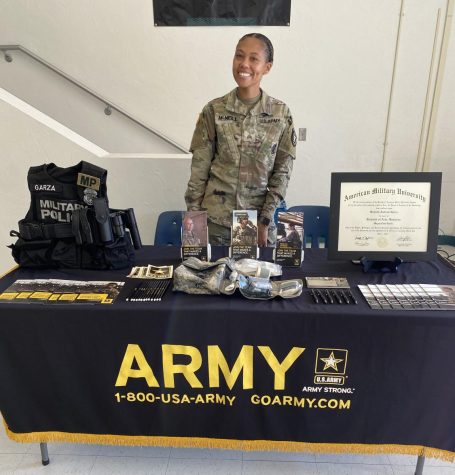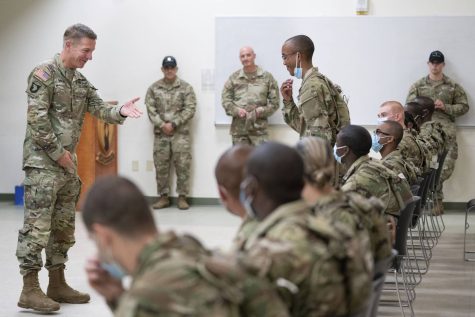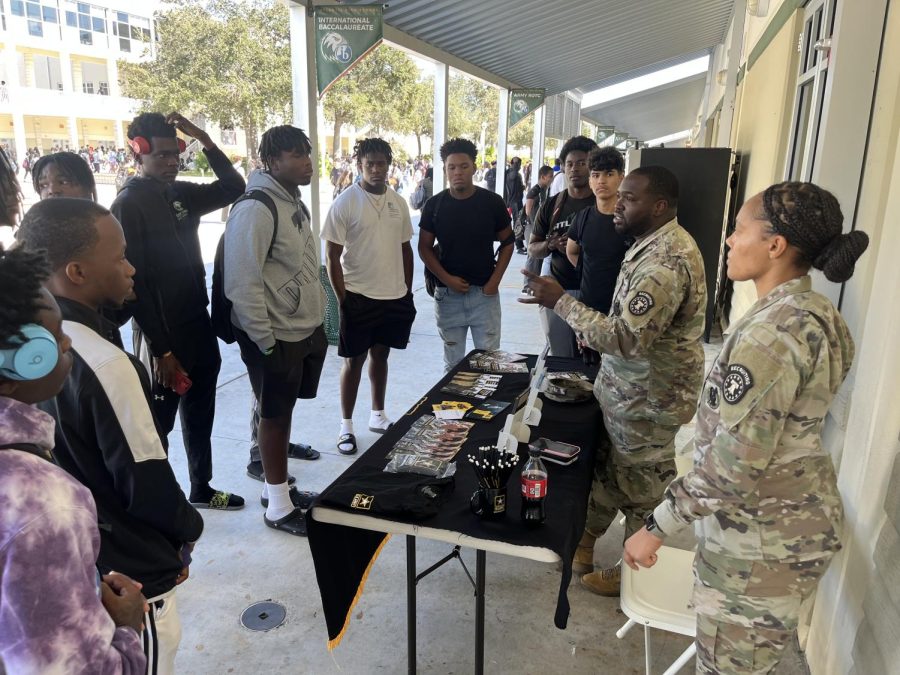Programming new enlistments: The evolution of U.S. Army recruiting strategies
In 2022, the Army fell 15,000 recruits short, which had recruiters reevaluating their strategies.
Sgt. Jessica McNeill and Senior Sgt. Devaughn Williams speaking with Atlantic High School football players about Army opportunities during lunch at their weekly table set up. Jan 12, 2023. Courtesy of Jessica McNeill.
April 25, 2023
For some, the decision to enlist in the military is largely driven by well-established passion and a desire to fight for their country. For others, recruitment effort is the leading factor in their decision.
Col. Tim MacDonald, a military fellow with the Council on Foreign Relations with over 25 years of active military service, explained that he was not recruited, but instead sought out the military. He started his journey at the New Mexico Military Institute, where he joined Reserve Officers’ Training Corps (ROTC) entering active service as an Army 2nd lieutenant. His most recent assignment was director of operations for the Combined Joint Task Force at the Horn of Africa in Djibouti, Africa.
Military enlistment experiences vary, especially in recent years. MacDonald shares COVID-19 kept recruiters and potential recruits from having face-to-face engagements, which in turn degraded recruiting efforts. He also believes that lower enlistment rates could be attributed to the lack of compelling reasons to join the military.
Big incidents such as 9/11, for example, cause a massive spike in numbers. Over 180,000 Americans joined the ranks of active duty service and nearly 73,000 joined the reserves after the attack, according to the official New York City website, NYC.gov. It has been 22 years since 9/11 and enlistment numbers have only lowered.
Another explanation for the recent drop in enlistments is exposure from family members who are currently serving or have previously served in the military.
“We’ve become a family business, if you will,” said MacDonald, adding that his views don’t necessarily match those of his employer.
Approximately 87% of those who serve in the military had and/or have family members in the business, according to MacDonald. Therefore, there is a great deal of youth who lack exposure to the military because they have no connections to it. For those kids, it is a matter of figuring out how to get involved.
That’s where the recruitment process comes in.
Military recruiters are responsible for interviewing, training, and evaluating potential candidates. They walk their candidates through the process of taking the ASVAB (Armed Services Vocational Aptitude Battery) test, completing the necessary paperwork, picking their specialty, and swearing them into the Army.
Capt. Sammy Firkins, company commander of the U.S. Army Recruiting Company in Jupiter, Fla., says traditional recruiting strategies still work to some extent.
“You know, telephone calls work, cold-calling still does work. But I do think social media is the way of the future just because that’s how the new generation talks to each other,” Firkins said. “I mean, I don’t know how many people can tell me their parents’ phone number right now without actually having to look at it. But you can damn sure know, they know their Twitter handle.”
Army recruiters still set up tables in hallways at noon, the cafeteria during lunchtime, and at sporting events at colleges and universities, because school outreach allows for the opportunity to find and inform interested students about the enlistment process in a comfortable setting.

“I think it is a very good and dependable way to recruit,” said Sgt. Jessica McNeill, an Army recruiter with the Jupiter Army Recruiting Company.
The 2022 recruiting goal for the Army was 65,000, but they fell 15,000 short — the equivalent of a division and a half. This sudden drop in enlistments caused recruiters to utilize social media more than ever before.
Sgt. Jessica McNeill was stationed in Hawaii when she volunteered to be a recruiter. Now, she recruits with the Lake Worth Recruiting Station in Greenacres, Fla. She uses multiple recruiting strategies but finds that social media has been most effective with the younger generation.
“I’ve noticed that it gains a lot of the younger generation’s attention,” said McNeill. “They’re all on social media. They’re all on their phones.”
McNeill said she may be in the Army, but she’s still a human, and using social media as a way of relatability to show that has brought in more potential recruits.
The U.S. Army Recruiting Command (USAREC) also created the following programs, each having an impact on different groups:
Buddy Program

USAREC introduced the Buddy Team Enlistment Option in May 2022, which ensures a group of up to four recruits the chance to undergo training together and eventually get assigned to the same duty station after graduation.
To qualify for the buddy enlistment option, each candidate must agree to pursue the same job and enlist on the same day, according to USAREC Public Affairs.
Future Soldier Prep Course

In August 2022, the U.S. Army started the Future Soldier Preparatory Course pilot program at the Fort Jackson training base in Columbia, South Carolina. This program gives potential candidates the chance to overcome academic and physical fitness barriers in order to meet the Army’s standards.
According to a Jan. 9 press release by the Initial Military Training Public Affairs Office, 92% of students enrolled in the course in 2022 graduated with the ability to continue to basic combat training.
Soldier Referral Program
In January 2023, USAREC introduced the Soldier Referral Program, which gives current soldiers an incentive to refer friends and family into the service and obtain a recruiting ribbon for their uniform as well as a promotion.
Firkins said recently there have been over 4,000 new army referrals and 66 new enlistments across the country since the launch of the program.
Editor’s note: This story is in the UP’s latest issue that can be found physically on the distribution boxes around campus or digitally through our Issuu page.
Elisabeth Gaffney is a Staff Writer for the University Press. For more information on this article or others, you can reach Elisabeth at [email protected] or DM her on Instagram @elisabethgaff.






